 A shekere (or sekere) is a beautiful and unique instrument originating in West Africa that appears in various shapes, sizes and forms throughout the continent of Africa. Made from a simple dried gourd with a beaded “skirt”, shekeres are a great addition to any environment where children are learning about music or world cultures.
A shekere (or sekere) is a beautiful and unique instrument originating in West Africa that appears in various shapes, sizes and forms throughout the continent of Africa. Made from a simple dried gourd with a beaded “skirt”, shekeres are a great addition to any environment where children are learning about music or world cultures.
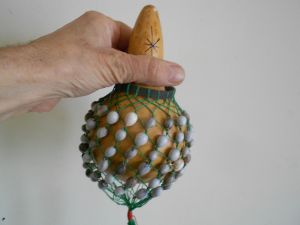 If you’re finding it hard to locate or purchase a shekere for your classroom, home or homeschool, you might consider making your own. Other then the dried gourd, the additional materials are easy to find and the beading process is “easy to moderate” for beginning crafters. In fact, since the stringing and beading is the part of the process that generates the most questions and confusion, we’ve partnered with Carrie P. from a wonderful blog called Crafty Moms Share to develop a step-by-step tutorial for making your own dried gourd shekere. (Complete gourd tutorial and other related shekere posts can be found at the links below).
If you’re finding it hard to locate or purchase a shekere for your classroom, home or homeschool, you might consider making your own. Other then the dried gourd, the additional materials are easy to find and the beading process is “easy to moderate” for beginning crafters. In fact, since the stringing and beading is the part of the process that generates the most questions and confusion, we’ve partnered with Carrie P. from a wonderful blog called Crafty Moms Share to develop a step-by-step tutorial for making your own dried gourd shekere. (Complete gourd tutorial and other related shekere posts can be found at the links below).
 Beads, Seeds, Nuts or Seashells
Beads, Seeds, Nuts or Seashells
Along with beads, almost any small, roundish, rattling object can be used as the noise-makers on a shekere. If you take a close look at the shekeres pictured above, you’ll notice beads as well as seeds woven into the netting. In Africa, some shekeres also use seashells or hard seeds or nuts with holes drilled though them as part of their unique design.
Add Some String
The skirt of a shekere is created from a type of string or twine that is durable and will not break or stretch. Since cotton twine will stretch, nylon or hemp is a better choice for creating a working shekere. Because the top circle or collar of the netting holds all the other strings in place, some craftspeople pick a thicker string for this or braid the twine for a more durable start to the project.
 And Some Knots!
And Some Knots!
With your collar in place around the gourds neck, you are ready to add the strings.
Cut a number of strings (enough to fit around the gourd) approximately 30 inches long. Fold each string in half and make a slip knot with it around the collar. To make a slip knot, put the folded string under the collar with the fold on top and then bring the ends through the loop of the fold and collar and tighten.
Once you have all the strings you desire in place you will tie a loop knot to secure each location. A loop knot is where you make a “6” with your strings and bring the end through the loop of it. This is the type of knot we will be using for the rest of the project.
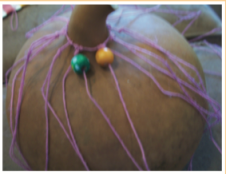 Add The Beads
Add The Beads
Here are Carrie’s great suggestions for getting the hang of adding beads to the skirt:
Adding the beads is where you creativity really comes into play.
You can do many different things with the beads. Some put a bead on each string, others put two strings through a bead. Some put a single bead between knots and others go up to three beads before knotting. The important thing is to work with a string from two different knots.
Once you have your bead(s) in place, tie a loose loop knot. I re-started many of mine because I did not like how the first round looked and found they lay better with looser knots. Do an entire round before starting the next.
Once you have one round complete, start the next. Stay consistent with however you’ve started with beads and knots, but again you want to use strings from different knots. This will bring the beads in the first round closer together. Continue doing a round at a time until you have the skirt you want.
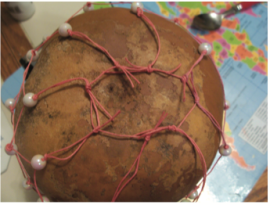 Finish The Instrument!
Finish The Instrument!
Here are Carrie’s two descriptions for two methods of finishing the skirt and completing the shekere:
Method 1: The first is to have another loop similar to the collar (braided if you used braided) and the same size. Then you tie your ends to the loop so it hangs loosely below the gourd.
Method 2: If your gourd is small you can take an 8-inch string and tie the ends together. This is easier to do with another person holding your shekere for you to tie them together.
 Making Music!
Making Music!
If you take a look at the resources below you’ll find many wonderful ways to check out the sound of traditional shekeres or explore music with the ones you’ve created.
Enjoy!
Complete Tutorials
http://www.teacherspayteachers.com/Product/Make-Your-Own-Shekere-African-Percussion-Instrument-Tutorial-992550
http://dariasvillagestore.storenvy.com/collections/34585-all-products/products/4084121-make-your-own-shekere-african-instrument-tutorial
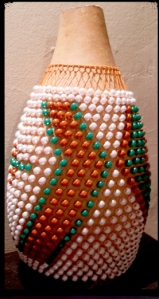 Links and Resources
Links and Resources
Hear A Shekere
http://www.dariamusic.com/shekere.php
Color a Shekere Online
http://www.dariamusic.com/color_Shekere.php
Carries Crafty Moms Share Blog
craftymomsshare.blogspot.com/
Sekere.com – Beaded Sekeres from Master Craftswoman, Sara Fabunmi
http://www.sekere.com
Cultural Value of the Shekere, Article By Sara Fabunmi
THE CULTURAL VALUE OF THE SEKERE
Make a Classroom Shekere (From A Gourd)
http://tinytappingtoes.wordpress.com/2013/08/05/easy-gourd-shekere-for-a-child-or-a-classroom/
Make a Recycled Shekere (From A Milk Jug)
http://www.dariamusic.com/make_Shekere.php
An Alphabet Shekere Game
http://www.trueaimeducation.com/2012/10/guest-post-learning-letters-with-an-alphabet-shekere.html
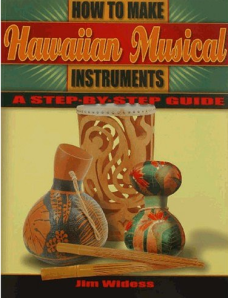 If you’ve ever seen authentic traditional music or dance from Hawaii, you’ve probably been struck by its beauty, grace and uniqueness. Although some of the instruments and traditions share roots in Polynesian culture, the islands of Hawaii have developed musical traditions and instruments that are deeply distinctive and singularly beautiful. And so many of the instruments are truly unusual – such as a knee-pad drum covered with the skin of a unicorn fish, gourd nose flutes, coconut bullroarers and even pairs of smooth river rocks used in a manner similar to castanets.
If you’ve ever seen authentic traditional music or dance from Hawaii, you’ve probably been struck by its beauty, grace and uniqueness. Although some of the instruments and traditions share roots in Polynesian culture, the islands of Hawaii have developed musical traditions and instruments that are deeply distinctive and singularly beautiful. And so many of the instruments are truly unusual – such as a knee-pad drum covered with the skin of a unicorn fish, gourd nose flutes, coconut bullroarers and even pairs of smooth river rocks used in a manner similar to castanets.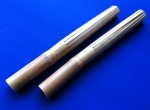 instruments used in Hawaiian music, check out the book: How To Make Hawaiian Musical Instruments, by Jim Widess. The book has detailed explanations of each instrument, historical background and many photos of the instruments being used by traditional players. Although the book is set up as a series of tutorials, the information is so good and so beautifully photographed that it serves as an exceptional introduction into the world of Hawaiian music.
instruments used in Hawaiian music, check out the book: How To Make Hawaiian Musical Instruments, by Jim Widess. The book has detailed explanations of each instrument, historical background and many photos of the instruments being used by traditional players. Although the book is set up as a series of tutorials, the information is so good and so beautifully photographed that it serves as an exceptional introduction into the world of Hawaiian music.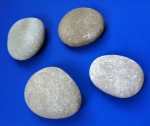 Ili’ile – river rocks used by dancers as percussion
Ili’ile – river rocks used by dancers as percussion  Play Some Pu’ili (Post in Tiny Tapping Toes)
Play Some Pu’ili (Post in Tiny Tapping Toes)


































 The beautiful, wide and diverse continent of Africa has some truly amazing and clever musical creations. One of my favorites is a small percussion instrument called a tongue rattle. Generally made from carved wood, the rattle is shaken quickly back and forth and a “tongue” within the two carved sides makes a noise like a person who just can’t stop talking.
The beautiful, wide and diverse continent of Africa has some truly amazing and clever musical creations. One of my favorites is a small percussion instrument called a tongue rattle. Generally made from carved wood, the rattle is shaken quickly back and forth and a “tongue” within the two carved sides makes a noise like a person who just can’t stop talking.
 of the cup. Here’s a picture of what that might look like.
of the cup. Here’s a picture of what that might look like. Play Your Tongue Rattle
Play Your Tongue Rattle Win a Carved African Tongue Rattle
Win a Carved African Tongue Rattle Musical instruments can be as diverse as the many peoples and cultures on the planet. One of my favorite unique instruments is a traditional rattle from comes from Afro Peruvian culture called the quijada. Made from the jawbone of a donkey (the word quijada means jawbone in Spanish), the instrument looks more like an artifact from a museum than an instrument used in a musical band! And, it’s loud. The jawbone is held in one hand and punched firmly with the other fist. When the long teeth shake back and
Musical instruments can be as diverse as the many peoples and cultures on the planet. One of my favorite unique instruments is a traditional rattle from comes from Afro Peruvian culture called the quijada. Made from the jawbone of a donkey (the word quijada means jawbone in Spanish), the instrument looks more like an artifact from a museum than an instrument used in a musical band! And, it’s loud. The jawbone is held in one hand and punched firmly with the other fist. When the long teeth shake back and  forth in the sockets, a loud, rattling or buzzing sound is created. Since the teeth are slightly uneven, some percussionists also play this jawbone by dragging a stick or rasp over it like a guiro.
forth in the sockets, a loud, rattling or buzzing sound is created. Since the teeth are slightly uneven, some percussionists also play this jawbone by dragging a stick or rasp over it like a guiro. Get Your Supplies
Get Your Supplies A Monster Rattle
A Monster Rattle Time To Play!
Time To Play!